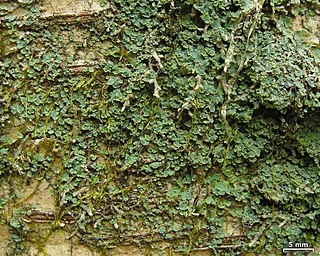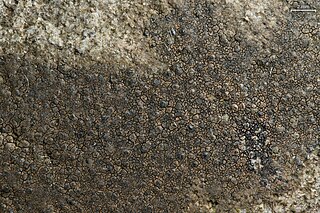
Verrucariaceae is a family of lichens and a few non-lichenised fungi in the order Verrucariales. The lichens have a wide variety of thallus forms, from crustose (crust-like) to foliose (bushy) and squamulose (scaly). Most of them grow on land, some in freshwater and a few in the sea. Many are free-living but there are some species that are parasites on other lichens, while one marine species always lives together with a leafy green alga.
Clavascidium is a genus of lichens in the family Verrucariaceae. The genus was circumscribed in 1996 by Austrian lichenologist Othmar Breuss. Because the type species of the genus, Clavascidium umbrinum, has been shown using molecular phylogenetics to belong to genus Placidium, Cécile Gueidan and colleagues proposed to unite Clavascidium with Placidium in a 2009 publication. Despite this, the genus has been retained in recent publications of fungal classification.

Thelidium is a genus of lichen-forming fungi in the family Verrucariaceae. The genus was circumscribed in 1855 by Italian lichenologist Abramo Bartolommeo Massalongo, who assigned Thelidium amylaceum as the type species.

Normandina is a genus of lichen-forming fungi in the family Verrucariaceae. It has five species of crustose and squamulose (scaly) lichens.

Porpidia is a genus of crustose lichens in the family Lecideaceae.

Palicella is a genus of crustose lichens in the family Lecanoraceae. It contains six species.

Hydropunctaria is a genus of saxicolous (rock-dwelling), crustose lichens in the family Verrucariaceae. The genus includes both aquatic and amphibious species, with members that colonise either marine or freshwater habitats. The type species, Hydropunctaria maura, was formerly classified in the large genus Verrucaria. It is a widely distributed species common to littoral zones. Including the type species, five Hydropunctaria lichens are considered marine species: H. adriatica, H. amphibia, H. aractina, H. orae, and H. oceanica.
Atla is a genus of crustose lichens in the family Verrucariaceae. It has nine species that grow on rocks or on soil.

Willeya is a genus of saxicolous (rock-dwelling), crustose lichens in the family Verrucariaceae. It has 12 species. Most species are found in southeast Asia, although individual representatives are known from Australia, Europe, and North America.
Verrucaria madida is a species of saxicolous (rock-dwelling), aquatic, crustose lichen in the family Verrucariaceae. Found in Europe, it was formally described as a new species in 2004 by British lichenologist Alan Orange. The type specimen was collected by the author west of Murat, Cantal, France at an altitude of about 1,000 m (3,300 ft). There it was growing on shallowly submerged rocks in a lightly shaded woodland stream. The lichen has a thin, smooth, dark green to dark greenish-grey thallus with a somewhat gelatinous consistency. The asci of Verrucaria madida contain four ascospores; this is highly unusual for genus Verrucaria, which typically has eight-spored asci.
Hydropunctaria rheitrophila is a species of freshwater, saxicolous (rock-dwelling), crustose lichen in the family Verrucariaceae. It was formally described as a new species in 1922 by German lichenologist Georg Hermann Zschacke as a species of Verrucaria. Christine Keller, Cécile Gueidan, and Holger Thüs transferred it to the newly circumscribed genus Hydropunctaria in 2009. It is one of several aquatic lichens that are in this genus. The photobiont partner of Hydropunctaria rheitrophila is a yellow-green alga.
Trimmatothele is a genus of saxicolous (rock-dwelling), crustose lichens in the family Verrucariaceae. It has five species. The genus was formally published by lichenologist Alexander Zahlbruckner in 1903. The type species, Trimmatothele perquisita, was originally collected from Norway by Johannes M. Norman, who placed it in the genus Coniothele in 1868. Diagnostic characteristics of Trimmatothele include a thin thallus with a smooth surface; small perithecia that are partially immersed in the substrata and have an involucrellum; asci that contain multiple ascospores; and small, simple ascospores. Trimmatothele has been described as one of the most poorly known genera of lichens due to the rarity of its species, the few available herbarium specimens, and some missing type specimens.
Psoroglaena stigonemoides is a species of corticolous (bark-dwelling) lichen in the family Verrucariaceae. It occurs in Great Britain and Ireland. It was first described scientifically by lichenologist Alan Orange in 1989, as Macentina stigonemoides. He collected the type specimen from Cardiganshire, Cambria, where it was found growing on the bark of Ulmus glabra in a humid forest. Aino Henssen transferred it to the genus Psoroglaena in 1995.
Verrucaria nodosa is a species of saxicolous (rock-dwelling), crustose lichen in the family Verrucariaceae. Found in freshwater habitats in Wales, it was formally described as a new species in 2013 by lichenologist Alan Orange. The type specimen was collected by the author north-west of Llanuwchllyn, Merioneth, where it was found growing on an unshaded rock in a stream. The lichen has a grey-green to dark brown thallus with an uneven surface crust. Its ascomata are in the form of somewhat convex to hemispherical perithecia measuring 220–460 μm in diameter, with an inconspicuous or tiny ostiole. Ascospores are ellipsoid and colourless, lack any septa, and typically measure 20.5–22.2–24.0 by 90–97–105 μm. The species is known only from a few streams in Wales, where it grows on shaded or lightly shaded rocks. Associated lichen species include Ionaspis lacustris, Rhizocarpon lavatum, Porpidia hydrophila, Sporodictyon cruentum, and Trapelia coarctata, as well as the mosses Racomitrium aciculare and Scapania undulata.
Verrucaria rosula is a species of saxicolous (rock-dwelling), crustose lichen in the family Verrucariaceae. Found in freshwater habitats in Europe, it was formally described as a new species in 2013 by lichenologist Alan Orange. The type specimen was collected by the author from Cwm Dringarth, Brecon Beacons (Brecknockshire), where it was found growing on an unshaded rock in a flush. The lichen has a grey-green to brown thallus that is 40–200 μm thick. New thallus growth is initiated by tiny, roughly spherical or polyhedral granules that increase in size to eventually form somewhat circular, rosette-like patches; the species epithet rosula refers to this type of growth. Verrucaria rosula has been recorded in Wales, southwest England, Scotland, and France, where it occurs on damp siliceous rocks and stones near streams or on flushed ground. Lichens that associate with V. rosula include Ionaspis lacustris, Thelidium pluvium, Verrucaria cernaensis, V. hydrophila, V. sublobulata and V. margacea.
Verrucaria placida is a species of saxicolous (rock-dwelling), crustose lichen in the family Verrucariaceae. Found in freshwater habitats in Europe, it was formally described as a new species in 2013 by lichenologist Alan Orange. The type specimen was collected by the author south of the Moelvi river, where it was found in woodland, growing on a stone in a shaded stream. The species epithet placida, derived from the Latin word for "quiet" or "peaceful", refers to the "smooth, unbroken thallus and the characteristic but unstriking appearance of this lichen". Verrucaria placida has been recorded in Norway, southern Germany, and Wales, where it occurs in small streams and grows on shaded siliceous rocks and stones.
Verrucaria hydrophila is a species of saxicolous (rock-dwelling), crustose lichen in the family Verrucariaceae. Found in freshwater habitats in Europe, it was formally described as a new species in 2013 by lichenologist Alan Orange. The type specimen was collected by the author from Melindwr, Coed y Fron Wyllt, where it was found in a woodland growing on a shaded stone in a stream. The lichen has a thin, smooth, grey-green to brownish thallus that is somewhat translucent when wet. It is widespread in Europe and the British Isles, where it grows on rocks and stones in streams and seepages; the species epithet refers to its semi-aquatic habitat.

Verrucaria viridula is a common and widely distributed species of saxicolous (rock-dwelling), crustose lichen in the family Verrucariaceae. Although it is a somewhat morphologically variable species, two persistent distinguishing characteristics are its relatively large perithecia, which are often curved into a beak, and its large ascospores.
Alan Orange was a British lichenologist. His research interests included lichen taxonomy and phylogenetics, aquatic lichens, and the family Verrucariaceae.







